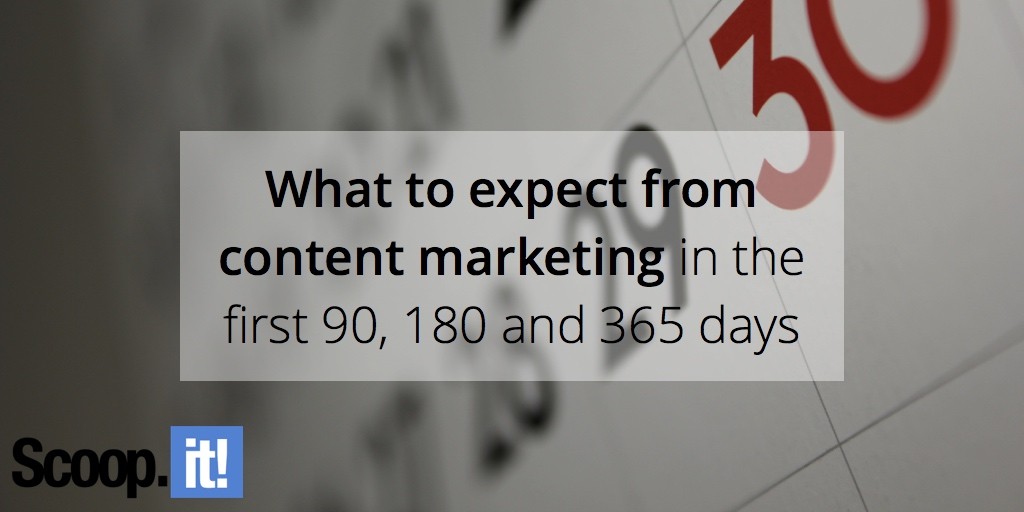
So you want to do content marketing. You’re going to put up a blog, start publishing once a week, and the new customers will just start pouring in.
Alas, no.
Alright… I suppose it is scientifically possible your world-class prose will bowl people over so completely that they’ll share every word you write. Just a mention of a blog post from you will inspire thousands to buy your company’s products and services.
But that would not be a normal result. Most blogs – even good blogs – take time to gain traction. So do most content marketing programs, and even most SEO efforts.
I don’t want to turn you away from content marketing (it works, and we love it, and it’s getting more effective all the time). But you shouldn’t launch into it expecting miracles. Outsized expectations are bad for business. They can be hard on staff and company morale, too.
So don’t expect an immediate return on investment with content marketing. It’s the sort of thing that builds upon itself, growing in phases.
To help you set some expectations for each of those phases, we thought it might help to define the phases of development for a typical content marketing program. That way you can know what to expect at day 90, 180 and 365.
So here’s how to build a bridge from a starting position you’re in now to a full-fledged content marketing program.
Walk: The first 90 days
For the first 90 days, you’re basically just developing and refining consistent content production. The primary KPIs you’re after in this phase are content volume and audience growth.
You’ll:
- Strategically choose 2-3 social media platforms to have a presence on.
- Spend about one day doing a SWOT (Strengths, Weaknesses, Opportunities, Threats) analysis of your core competitors content. Don’t drown yourself in data, but do get familiar with the content that’s currently available to your audience. Note any obvious gaps.
- Define your buyer personas. No more than a page for each of them. And no more than five personas, max. You can update this and make it fancy later.
- Write out a bullet list of the buyer’s journey for each persona. Again – keep it simple. You should be flexible and open minded with personas and buyers’ journeys now.
- Write out your content strategy. It doesn’t have to be more than two pages. Just a) have one and b) write it down.
- Write out an editorial statement. A page will do.
- Launch your blog. By this I mean design and build the blog itself. We’ll talk about content more in a moment. Make sure your blog is mobile-friendly and loads fast (as in each page loads in 2 seconds or less).
- Choose an email service provider. Set up your opt-in forms and create a welcome email.
- Begin curating content. You’ll publish one curated post a week on your blog, plus you’ll be curating on your social media accounts. Then you’ll roll all that into a weekly newsletter.
- Do some keyword research. Search engines have evolved enough that they think of keywords more as topics now. But that doesn’t mean you should be ignorant of the terms your audience is using for things. Develop a loose list of about 15-20 keyword topics. Then decide on about 5-7 specific keywords for each topic area. Use these terms in your content, but with a light hand.
- Install the WordPress plugin Yoast to help with SEO optimization.
- Publish one blog post of your own every week. This in-house content should address a common question or issue your audience has.
- You will probably also need to create one piece of long-form content, like an ebook. You’ll need this for lead generation, but it’s also a way to develop a sizeable content investment that can be repackaged into a bunch of different forms. Consider partnering with another company or with an influencer to reduce your time investment here. Also consider starting work on this piece of content about a month after you’ve begun curation and weekly blog posts. You’ll know your audience a bit better by then.
- Promote all this content. On social media, with influencers, and even with a little paid budget. And, of course, through your email list.
- Track results, either with Google Analytics or another tool like Scoop.it Content Director. Set up Google’s Search Console, too (just let it gather data for now).
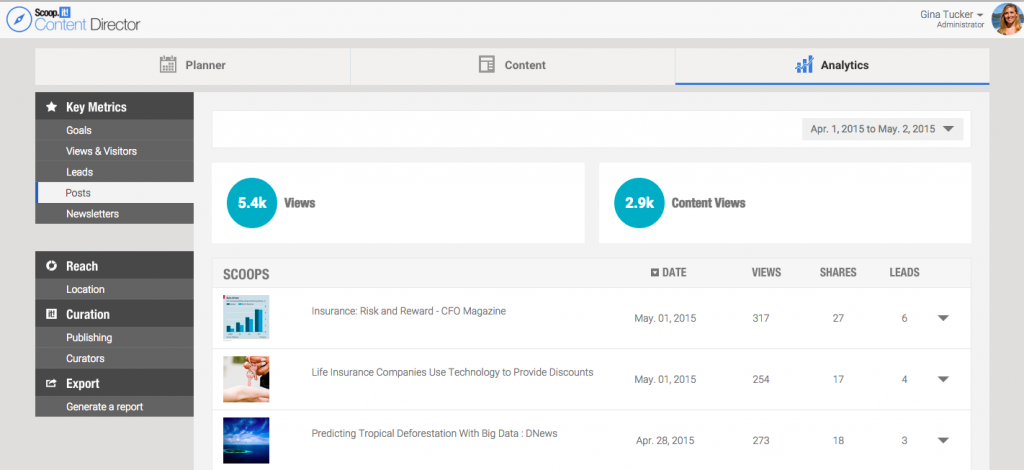
Scoop.it’s Content Director lets you see which content is performing best – without shifting through a lot of data.
Congratulations. You are now running a nice little content machine.
Jog: Days 90 to 180
By now you’ve got a base of content. Let’s get some more traffic from it.
- Check your results from the first three months. Which pieces of content got the most inbound traffic? Make more content like that – at least three new blog posts specifically designed to attract traffic.
- Check your analytics. Which content pieces or tactics are generating the most leads? Plan three more blog posts specifically targeted to get more leads.
- See if you can’t swap a guest post with an influencer… or five. Here’s how it might work: You write a post on the influencer’s (or publication’s) blog. They write a post on yours. The goal here is to start creating content partnerships with people in your industry. These partnerships can drive significant traffic to your content.
- Create 1-3 new long-form or high value lead generation content pieces. Pick these topics based on what performed well in the first three months, and what would be of most use to your primary buyer persona.
- Pay attention to what your audience is interested in, while hopefully addressing your business needs at the same time. When in doubt, put your audience first.
- Do a micro-content audit of everything you’ve done so far. It’s kinda early to see results, but this will give you a baseline for later work. Optimize lightly where you see opportunities.
- Set up a system for promoting your content. In the first three months, there was a lot of trial and error. That’s good. But now, shift into doing what works most of the time. Continue to test new promotion tactics, but only about 20% of the time.
- Promote your “old” content too. Figure out which content has done well (say, the top third of your content that performed best). Then share and re-share it every week. Use marketing automation software to re-share this content and to save yourself some time. Set up a system to re-share all your new content once a week for the first year after publication.
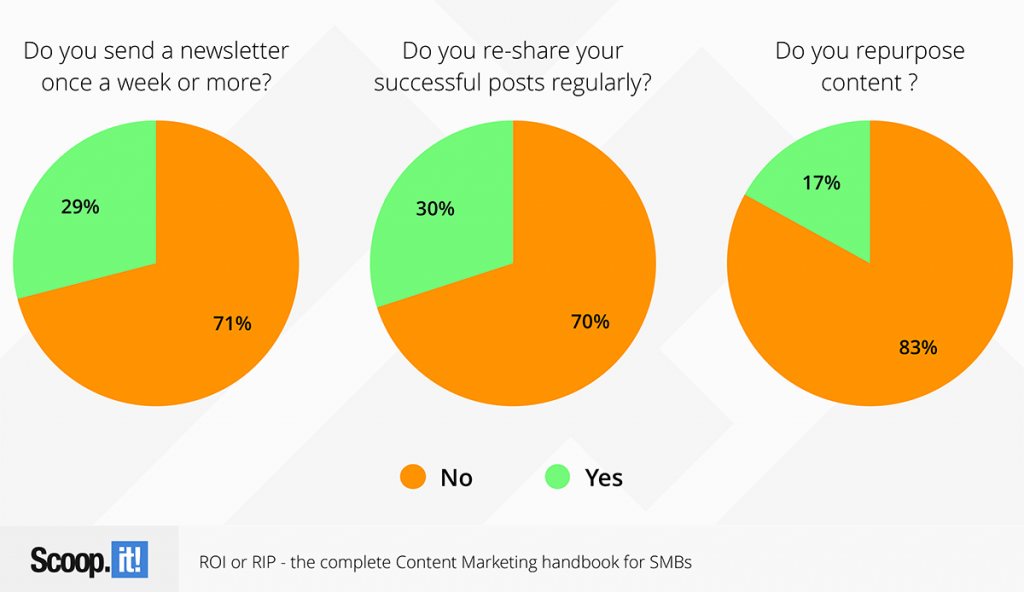
Some of the simplest, effective content marketing best practices are skipped over by most content marketers.
- Set up a system for reformatting content. This probably means hiring some design help. Do whatever it takes – everything you publish should be converted into at least three different formats. For example, a blog post becomes social media posts, a SlideShare, and content for an email newsletter. At the very least.
- When you hit the three-months mark, consider hiring freelance or part-time help. This won’t apply to everyone (most content marketing teams are actually very small). But if you know of a couple of tasks you could outsource, and you’ve got the budget… then outsource them.
- Don’t let up on your email marketing and list building efforts. Email is the best way to promote content. It’s also one of the best ways to get traffic to your site. Send something good to your list once a week.
- Remember that welcome email? Go back and rework it to showcase your top-performing content of the last few months.
Congratulations. Your content marketing system is probably more effective and efficient than most of your peers’. Already.
Run: Days 180 to 365
By now you’ve learned a massive amount about how to systematize content creation, promotion, and analysis. You’ve got the bones of a successful content marketing program. Now it’s just a matter of optimizing what you’ve done so you can amplify your results… all the way to a positive return on investment.
And, sure enough, your primary KPI for this phase is conversions. For most of you, that’ll be leads. We’re also going to try to maximize the life of your content while keeping all those other content marketing balls in the air (whew!).
Here’s your to do-list:
- At the six-month mark, assess which pieces of content have gotten the most leads. Ask yourself: Is there a way to get these top-performers to perform better? Do they need some SEO work? A more targeted lead magnet? An editorial update?
- Consider your lead generation offers. Are there any obvious content assets you need, but don’t have?
- Find out which pages are getting traffic, but that are not generating leads. What could be the problem? Is the lead gen offer a mismatch? Is the page really about something different than what the title tag says it is?
- Roll out your buyer personas pages and buyers’ journey information. Do you have content for each one of those personas, at each stage of their journey? If not, add that to your content production list.
- Consider setting up some tests for your lead generation offers. Test things like where the call to action is, what they copy for the call to action is, what cover art might convert better.
- Consider split-testing your opt-in forms, too.
- Keep testing and optimizing your content amplification and promotion tactics. By now, you should have enough content that there’s almost competition for space in your social media feeds. That’s not a problem – cut the low-performers and make way for your best ones.
- Spend months six through twelve optimizing, filling content gaps and testing. At the one year mark, run a detailed content audit all over again.
- Also at the year mark… guess what? It’s time to update the content you created early last year. Republish after you’ve updated and optimized it.
Congratulations. You’ve hit the optimization and amplification stage. You’re probably at a point now where you won’t even want to publish more often. Instead of publishing more, you’ll be publishing smarter. And your reformatted and republished content will fill up a lot of your content production. New content will keep coming, of course, but it will probably be about a third or less of your overall content assets.
The ROI Finish Line: Sometime around (but hopefully before) day 548
Hopefully you’ll achieve positive ROI for your content marketing program long before day 548 rolls around on the calendar. But be ready – not all companies make a profit in the first 18 months of their content marketing. And it’s not unheard of to take two or even three years to see ROI.
How can this be? Well, because building an audience takes time. And while there are plenty of people to tell you it’s easy (simple, but not easy) and that there are shortcuts (there are)… there are just as many people who are smart and work hard and still need 18 months or more to see a profit.
So what does this mean for you? For starters, it means budget. Can your content marketing budget last 18 months before it sees its first return on investment? Can it hold out to two years? More?
This is where the content marketing long game really matters. It’s this sort of long view and preparation that can keep you from putting your company’s business needs ahead of what your audience wants. With the right expectations and a sane budget made to last 2 or more years, you can hold to your content strategy plan and stay true.
Otherwise, when you’re a few months in, and there’s no ROI yet, you’ll be vulnerable to panic.
I have yet to see panic serve anyone well.
Conclusion
Does this all seem like a lot of work? It is – I cannot lie. But if you step back, all we’re really talking about is this:
When you first start out, you’re progressing through that cycle with just a little bit of content. Then the next time around, you’ve got more content – hopefully better-targeted content and better-performing content.
And then around and around you go. Constantly optimizing, amplifying and getting better returns. Minus all the little human mistakes along the way, of course. But hopefully we learn from those.
Back to you
What kind of results were you seeing from content marketing at day 90, 180 and 365? How long did it take your company to see a positive ROI? Tell us about it in the comments.
If you want to get 30 effective techniques to master content marketing along with valuable insights from 10+ influencers like Mark Schaefer, Rebecca Lieb, Lee Odden, Jason Miller or Ian Cleary, download our free eBook now!
Image by Dafne Cholet

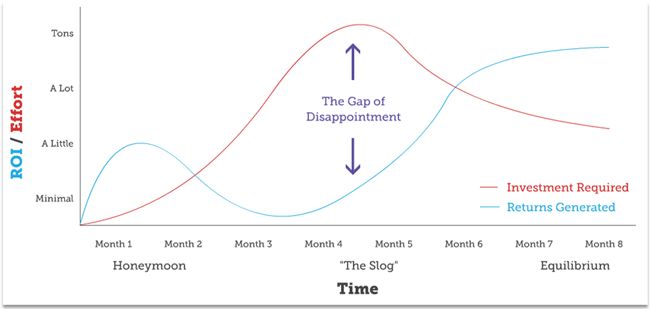
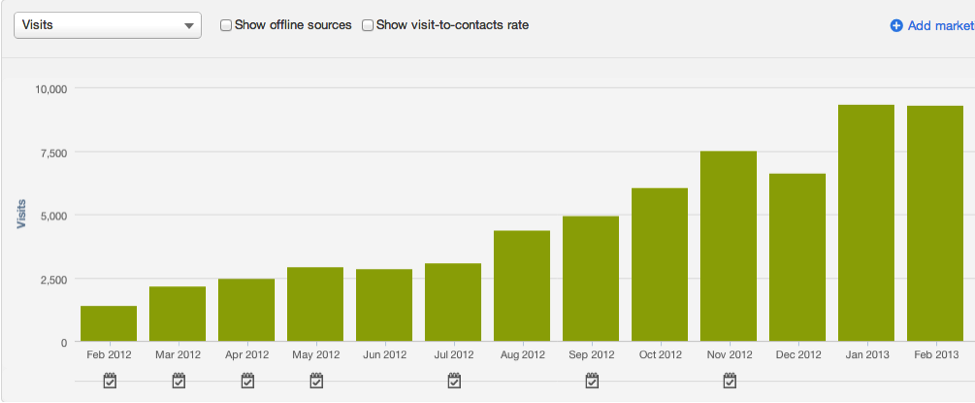
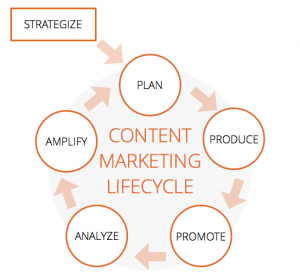


This is a great article! It is a very logical and well planned approach to content marketing.
I second that Elissa. Very informative and just what I was looking for. Thanks Pam!